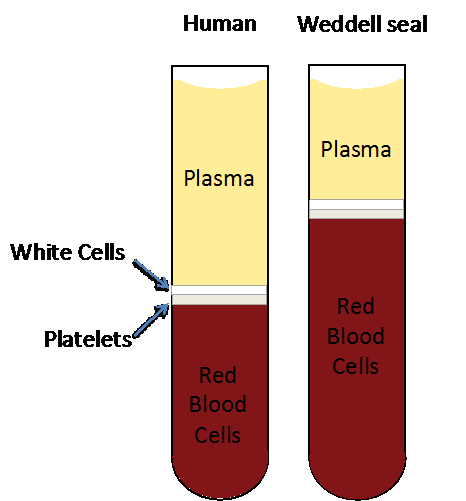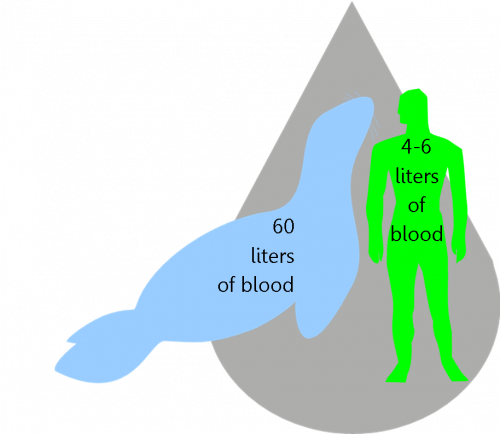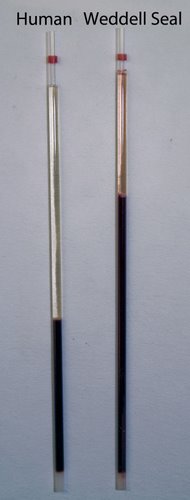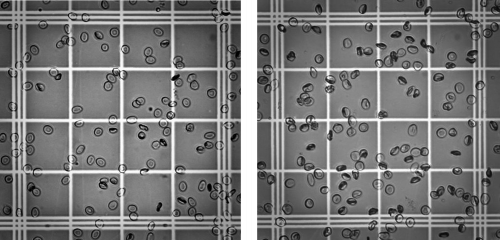
This journal brought to you by:
- Mrs. Lovgren’s students at St. Louis School in Illinois
- Johnny Wilson in 7th grade at Crosswind Elementary
Weddell Seal’s Blood
Blood!
It makes some of us a little queasy, but it plays a very important role for all mammals. You and I have blood – so does the Weddell seal. My question is… is all blood the same? Let’s take a look at the parts of blood and the role each part plays.
What’s in blood?
There are four main parts of all blood: red blood cells, white blood cells, platelets and plasma. Each part plays a different role. Let’s take a closer look!

Plasma consists of water, sugar, fat, protein and electrolytes (salts). It transports cells, nutrients, proteins, hormones and waste throughout the body.
Platelets attach to broken/ruptured blood vessels in wounds and start the clotting process. Once that happens, healing can begin.
White cells protect the body by fighting infections from invading bacteria, fungi and viruses.
Red cells contain hemoglobin, which carries oxygen from the lungs to other parts of the body.
Let’s compare human blood and seal blood…
Human blood and seal blood are a little different. Looking at the diagram above, you can see that the biggest components of human blood are red cells (35-45%) and plasma (50%). White cells and platelets each make up only about 1%. For seals, the main difference is the red cells. Why? It’s all about oxygen!

Weddell seals have about 10 times more blood (total volume) in their bodies than an average adult human! Humans have about 4-6 liters as compared to about 60 liters in the much larger seal.
You might expect an animal much larger than a person to have much more blood, but it’s not just because they have bigger bodies. In our bodies, blood makes up 7-8% of our weight, but in a Weddell seal’s body, blood makes up 20-22% of their body weight. That means Weddell seals have as much as 3 times more blood for each pound of their bodies and compared to humans. Wow!
More blood, higher red cell volume… these differences add up to be pretty big. But why do these seals need so much blood? And what can more red cells do for them? Like I said earlier, it’s about the oxygen. Seals need a lot of oxygen for their dives. Remember, they are mammals, so they need to breathe air – but they spend a lot of time under water. Seems like a problem...
Their bodies are specially adapted to solve this problem. They have more blood to carry more red cells, and they have more red cells to carry more hemoglobin; more hemoglobin means that they can carry more oxygen.
Now remember, one of the main jobs of red blood cells is to transport oxygen from the lungs to all the living tissues and organs in an animal’s body. Since I’ve been down here we’ve been taking blood samples on each seal to see:
The percentage blood that is made of red blood cells – hematocrit level
The total number and size of the red blood cells
The amount of oxygen carrying pigment - hemoglobin level
Testing these things tells us, in part, about the animal’s health and how much oxygen the seal can store.
Hematocrit
Hematocrit is the packed volume of red blood cells in your blood. In other words, your hematocrit level tells you how much of your blood is actually made up of the oxygen carrying red blood cells.
** Hematocrit = percent volume of red blood cells**


Still, knowing the hematocrit, or volume of red blood cells, does not necessarily tell us how many red blood cells the seals have. The space taken up by red blood cells in the blood could be from either having a lot of very small red blood cells, or from having fewer, larger red blood cells. That is why we also count red blood cells for the Weddell seals.
Red blood cell counts and size
We count how many red blood cells the seals have using a hemocytometer and microscope. These grids are designed to hold a specific amount of liquid. By counting the number of red blood cells on this grid, we can determine how many cells there are in a given amount of blood.

Go to ‘Ask the Team’ and reply to the discussion thread ‘Red Cell Count’ to let me know your answers!
Hemoglobin
Hemoglobin is a special protein in the red blood cells that binds to oxygen and carries it from the lungs to the rest of the body. It then returns carbon dioxide from the body to the lungs so it can be exhaled.
Hemoglobin = oxygen carrier
No matter what kind of mammal you look at, their hemoglobin will bind to the same amount of oxygen. But some species have more hemoglobin than others. Who do you think has more hemoglobin? If you guessed Weddell seals, you’re right! My hemoglobin level was 12.3%, but the Weddell seal we measured had 20-28 grams of hemoglobin protein in 100 milliliters of blood (20-28%).


Comments